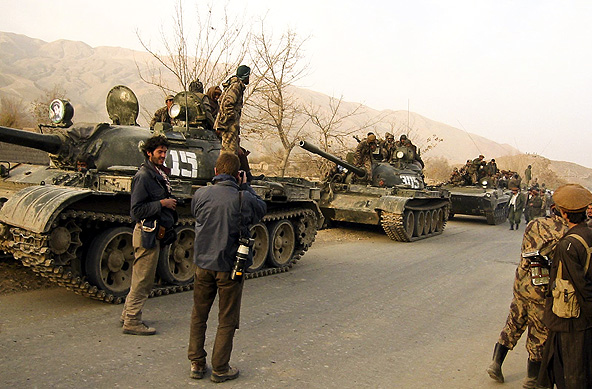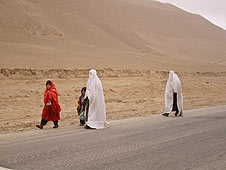
19 November, 2001, Bangi Pol, Afghanistan. Sion Touhig and James Hill near a column of Northern Alliance tanks.
Photo: Phillip Robertson
"We're wasting time, let's go now."
"I want to ask these guys where the front is."
"The front is down there, going toward Kunduz. Come on."
"What if it isn't? This could be it."
I was starting to have this feeling that Kunduz was not at all finished, and that tales of Kunduz's fall had been greatly exaggerated. Nazar got out with me and we started to ask various commanders questions. The answer came back, "You can't go forward." Nazir asked him why we couldn't proceed.
"Because this is the front line."
A commander pointed to a nearby village where we watched the lights of the mujahedin pickups and jeeps as they drove through the town like crazy. "See that village? It is Taliban." I didn't see any shooting, but there was enough activity to make me think there had just been a firefight. We were hearing bursts of gunfire, and I couldn't figure out where it was coming from. I went back to the jeep and told Sion to forget about going on to Kunduz. After a long heated argument about why we should keep going because it was safer to go west than to go back east, since we were somewhere in the middle. I walked away and Sion got out of the jeep and ran straight into a bunch of his colleagues. One of them was James Nachtwey, a celebrated photojournalist who has documented wars at terrible personal risk. For me that was signal: If Nachtwey had stopped, it would be absurd to keep driving.
At one point when we were conferring with the mujahedin and the other journalists who had come this far, we looked back toward Amin's pristine jeep and saw clouds of hashish smoke billowing from the windows. For a second, I thought he'd set it on fire. We piled back into the jeep and turned back for Bangi, as the stars burned in their dark curtain, watching the road very carefully. In Sufi Momeen's restaurant in Taloqan, we found the entire clientele holding portable radios to their ears, where I heard the unmistakable nasal whine of Daoud Khan giving a speech.
"What's that, Nazar?"
"Daoud Khan on Radio Iran."
"Really. What's he saying."
"He says that the forces of the mujahedin are entering the city. He says that Kunduz has fallen." It was not true.
At Ludin, the road was open, so we could have continued on toward Kunduz. But if we'd kept going, all four of us would have been murdered. Our killers were waiting for us just down the road. The new plan was to wait until 4:30 the next morning and drive into the city.
Amin and Nazar were late and didn't show up until 6 a.m. When they arrived, we got in to the jeep and drove in complete silence out of Taloqan, west, through Bangi, up to the previous front line without seeing very many other vehicles and no checkpoints. Every so often, we would pass a truck full of fighters, but the road was quiet. In 20 minutes, we were at the huge crater across from Choge Nawabad. It was too cold to take notes; my fingers wouldn't write. Ten minutes later, we passed through Khanabad, and the mist was starting to burn off the rice fields. Amin, still unusually quiet, pulled over when we found the column very close to the spot where we had left it the night before. It was 7 in the morning. Nazar hadn't said a word.
Sion wanted to keep driving so he popped out of the jeep with his camera gear, and was immediately stopped by a group of five young mujahedin, who tried to explain to him that it wasn't possible to go any further down the road. Sion wouldn't have it. "I'm going to Kunduz, that's all there is to it." There were a few other photographers, standing in a bunch, 100 yards away and he wanted to go and join them, but the mujahedin were grabbing his clothes trying to hold him back. When they were all clutching at him, Sion pulled a great London pub-brawl move, suddenly raising his arms, sending all the armed guys scattering to the winds. From where I was standing, it seemed like the fighters exploded away from him as he walked down the road.
I told Nazar to run down and translate between Sion and the fighters. When Nazar got there, Sion didn't need a translator. He just told all of them to fuck off and kept on marching down the road. It was almost beautiful. Sion got smaller and smaller, looking a little top heavy in his Kevlar vest, while Nazar came running back to me with the crowd of mujahedin and said, "These men want to take the car and stop him." The fighters jumped into the jeep, ready to go. Amin froze, waiting for me to say something.
I spoke to the fighters in low tones, greeting them and carefully explaining that Sion was a war photographer and a lunatic, and that I would go down and talk to him myself, without anyone else present. And amazingly, they bought it, hook line and sinker, all of them getting out of the jeep politely and shaking my hand. The fighters told me through Nazar that there were Taliban holed up in a small white building near the road, and that Sion would be killed, but the breathless way they told me made me think it was bullshit. The mujahedin, almost to a man, were terrified of the Taliban, as if their enemy had been invested with supernatural powers. Amin drove me down to where Sion waited with the other photographers and just then, at around 7:30, the column started to move to Kunduz. It was a perfect morning. We walked with the mujahedin as they trundled along at 5 miles an hour, and after mile or so, I sent Nazar back to get Amin, because he was waiting for us. The photographers got great shots of fighters walking through the morning mist and some fighters pulled me into the back of their truck. They made a space for me on the bench, and I asked them the usual questions, holding up my end of the secret deal, which is:
 LEAD IMAGE: 20 November, 2001. Refugees on the road before the fall of Kunduz to the Northern Alliance.
LEAD IMAGE: 20 November, 2001. Refugees on the road before the fall of Kunduz to the Northern Alliance.Photo: Phillip Robertson
© Phillip Robertson, 2009-2014.
